How to Store Watches to Prevent Damages? | WatchWIX Comprehensive Guide
Hey there watch enthusiasts! Ever wondered how to keep your beloved timepieces safe and sound when they’re not adorning your wrist? Whether you’re a collector with an array of prized watches or simply want to maintain the integrity of your favorite everyday accessory, proper storage is key. In this guide, we’ll dive into some easy yet effective methods to store your watches. Let’s find out how to shield them from scratches, moisture, and other potential damages. So, let’s ensure your watches stay ticking beautifully for years to come!
Table of Content:
- Good options to store watches safely
- What factors will damage your watch when storing
- How should you mitigate the factors that will damage your watch when storing
- Step by step guide to store your wrist watches properly
- How to keep your watches safe in a watch storage box
- Best practices to store your watches while traveling
- Best practices when you are storing watch for long period
- Watch boxes vs watch rolls – what is the better way to store?
- How to choose a best box to store your watch?
Good options to store watches safely
There are several options to safely store watches, depending on factors like the number of watches you have, your budget, and the level of protection you need. Here are some popular options,
1. Watch Box/Case: A watch box or case is specifically designed to store and display watches. They often have individual compartments with soft cushions to keep watches secure and prevent scratches. Some come with locks for added security.
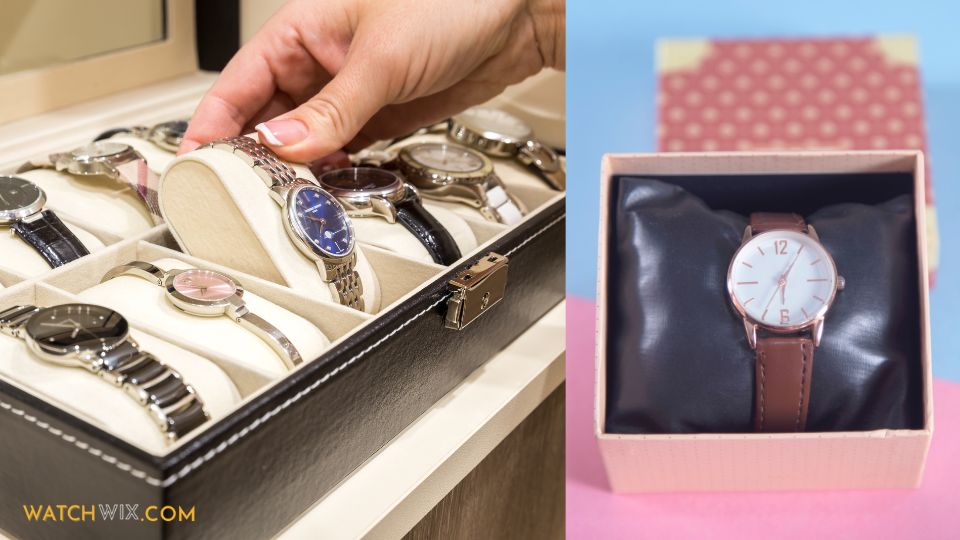
2. Watch Roll: A watch roll is a cylindrical or rectangular case made of soft material like leather or fabric. It typically rolls up and has slots to hold multiple watches securely. Watch rolls are great for travel or compact storage.
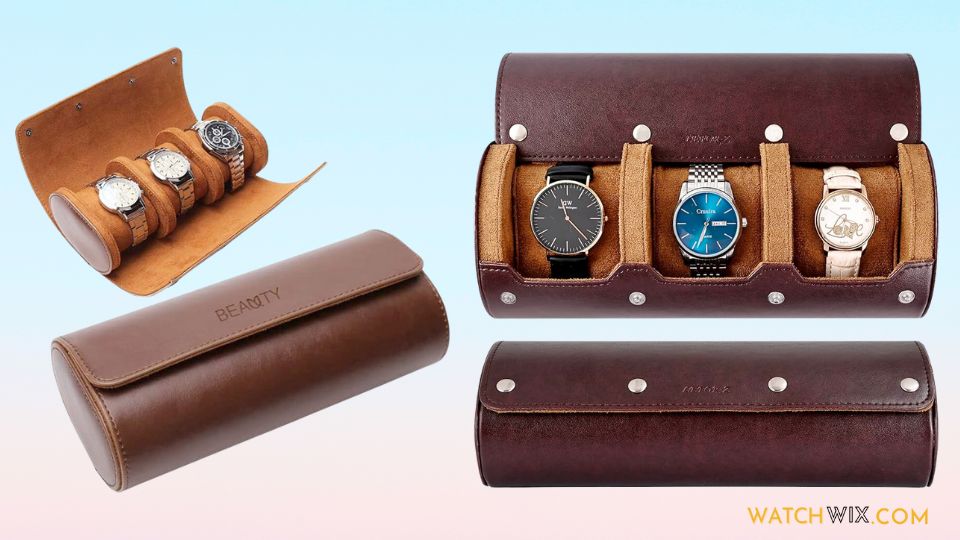
3. Watch Winder: If you own automatic or self-winding watches, a watch winder is essential for keeping them running when not worn. A watch winder rotates the watch at regular intervals to mimic the movement of wearing it. This prevents the lubricants from solidifying and ensuring accurate timekeeping.
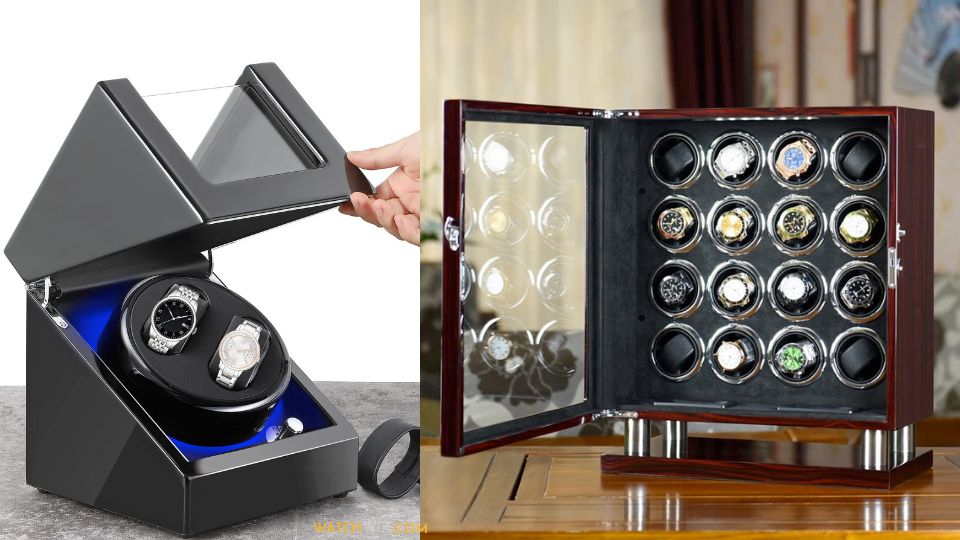
4. Safe or Safe Deposit Box: For valuable or high-end watch collections, storing them in a safe at home or a safe deposit box at a bank provides maximum security against theft and damage from fire or other disasters.
5. Drawer Organizer: You can use a drawer organizer with compartments to store watches. Make sure the compartments are padded to protect the watches from scratches and impacts.
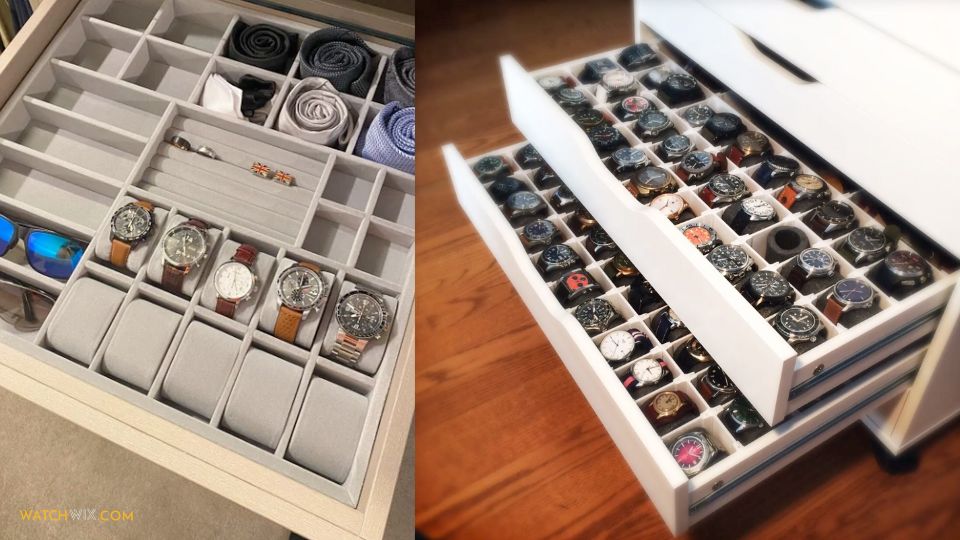
6. Display Cabinets: For showcasing your watch collection, a display cabinet with glass doors and shelves can be a stylish option. You have to ensure the cabinet has soft lining to prevent scratches.
What factors will damage your watch when storing
There are several factors can potentially damage your watches when storing your watches. Below are the things which you should beware.
- Moisture: Exposure to moisture can lead to rust, corrosion, and damage to internal components, especially for mechanical watches. High humidity levels or sudden changes in temperature can accelerate this process.
- Dust and Dirt: Accumulation of dust and dirt can scratch the watch case, crystal, and dial, diminishing its appearance over time. It can also find its way into the movement, affecting its performance.
- Direct Sunlight: Prolonged exposure to direct sunlight can cause fading or discoloration of watch dials, bezels, and straps. Additionally, heat from sunlight can affect the lubricants inside the watch, leading to potential issues with the movement.
- Magnetic Fields: Magnetic fields, such as those emitted by electronic devices like smartphones and speakers, can disrupt the accuracy of a mechanical watch’s movement. Storing watches near strong magnetic sources can lead to timekeeping inaccuracies.
- Physical Impact: Accidental knocks, drops, or impacts can cause dents, scratches, or even internal damage to the watch movement. Proper cushioning and protection are essential to prevent such incidents.
- Improper Storage Position: Storing watches in positions that put undue stress on the components, such as laying them flat or placing heavy objects on top of them, can lead to misalignment, damage to the crown or stem, and other issues.
- Chemicals: Exposure to chemicals like perfumes, lotions, and household cleaners can damage watch straps or cause discoloration on the case and dial. It’s important to avoid contact with such substances.
- Poor Ventilation: Storing watches in a poorly ventilated or airtight environment can promote the growth of mold and mildew, especially in humid conditions, leading to damage to the watch components and straps.
You can ensure that your watches remain in excellent condition while in storage, preserving their value and longevity by considering and mitigating these factors,
How should you mitigate the factors that will damage your watch when storing
To mitigate the factors that can damage your watch when storing, consider the following measures:
- Moisture Control: Store your watches in a dry environment with moderate humidity levels. Use desiccants like silica gel packets or dehumidifiers in your storage area to absorb excess moisture and prevent condensation inside the watch.
- Dust Protection: Keep your watches in a clean and dust-free environment. Store them in a closed watch box, case, or cabinet with soft lining to protect against dust and dirt. Regularly wipe down your watches with a soft, lint-free cloth to remove any accumulated dust.
- Sunlight Avoidance: Store your watches away from direct sunlight to prevent fading or discoloration. Choose a cool, shaded area for storage, or use UV-blocking glass in display cases to shield watches from harmful rays.
- Magnetic Shielding: Keep your watches away from strong magnetic fields to avoid interference with the movement. Store them in a location free from electronic devices and magnets, or use demagnetizing tools periodically to neutralize any magnetic effects.
- Protection from Physical Impact: Store your watches in a secure location where they won’t be knocked over or bumped into. Use watch boxes or cases with padded compartments to cushion watches and prevent damage from accidental impacts.
- Proper Storage Position: Store your watches in the correct position to avoid unnecessary stress on the components. For mechanical watches, store them in an upright position or on their side to prevent damage to the delicate movement.
- Avoid Chemical Exposure: Keep your watches away from chemicals like perfumes, lotions, and household cleaners that can damage the case, dial, or straps. Avoid spraying directly onto your watch and clean it with a damp cloth if it comes into contact with any substances.
- Ensure Adequate Ventilation: Store your watches in a well-ventilated area to prevent the buildup of mold and mildew. Avoid storing watches in airtight containers or humid environments, and consider using moisture-absorbing products to maintain optimal conditions.
By implementing these mitigation measures, you can effectively protect your watches from potential damage while they’re in storage, ensuring they remain in excellent condition for years to come.
Step by step guide to store your wrist watches properly
Knowing how to properly store your watches is essential despite you are a seasoned watch collector or simply want to preserve the durability of your timepieces. We will walk you through step-by-step instructions and best practices to ensure your watches remain in pristine condition for years to come. From choosing the right storage solution to implementing effective maintenance routines, you’ll learn everything you need to know to protect your investment and keep your watches ticking beautifully.
1. Assess Your Storage Needs
Before diving into storage options, take stock of your watch collection and consider factors such as the number of watches you own, their value, and your storage space. Assessing your needs will help you choose the most suitable storage solution.
2. Choose the Right Storage Container
Select a storage container that provides adequate protection against dust, moisture, and physical damage. Options include watch boxes, cases, rolls, display cabinets, and safes. Consider factors such as material, size, compartments, and security features when making your selection.
3. Organize Your Watches
Once you have chosen a storage container, organize your watches by size, style, or frequency of use. Use individual compartments or watch rolls to keep each watch separated and prevent scratches or damage from contact with other watches.
4. Clean and Maintain Your Watches
Before storing your watches, clean them thoroughly using a soft, lint-free cloth to remove any dirt, dust, or residue. Check for any signs of wear or damage and address them promptly. For mechanical watches, ensure they are fully wound or set to their resting position to prevent unnecessary stress on the movement.
5. Protect Against Moisture
Moisture is one of the biggest threats to watch longevity. Place silica gel packets or dehumidifiers in your storage container to absorb excess moisture and prevent condensation. Avoid storing watches in humid or damp environments, and consider using moisture-resistant storage solutions for added protection.
6. Shield from Sunlight and Magnetic Fields
Keep your watches away from direct sunlight and strong magnetic fields to prevent fading, discoloration, and interference with the movement. Store them in a cool, shaded area or use UV-blocking glass in display cases to shield them from harmful rays.
7. Monitor and Maintain Regularly
Periodically check your stored watches for any signs of damage or deterioration. Rotate watches in storage to ensure they receive equal usage and maintenance. Clean your storage container regularly to prevent dust buildup and maintain optimal conditions.
How to keep your watches safe in a watch storage box
Watches should be stored in a storage box to provide them with adequate protection against dust, moisture, sunlight, and physical damage. A quality storage box with soft, cushioned compartments helps prevent scratches and dents, preserving the appearance and integrity of the watches. Additionally, storing watches in a dedicated storage box helps organize and safeguard them from accidental impacts or exposure to harmful environmental factors.
Follow the below given steps to keep your watches safe in a watch storage box,
- Choose a Quality Storage Box – Invest in a high-quality watch storage box made from durable materials like wood, leather, or carbon fiber. Ensure that the box has soft, cushioned compartments to protect your watches from scratches and damage.
- Clean Your Watches – Before placing your watches in the storage box, clean them thoroughly using a soft, lint-free cloth to remove any dirt, dust, or residue. Check for signs of wear or damage, and address them promptly to prevent further deterioration.
- Keep your Watches Face Up – Despite how much soft material there is around the watch, the potential for damage is real if you lay them face down. Hence it is recommended to keep your watch face up during storage.
- Organize Your Watches – Organize your watches within the storage box by size, style, or frequency of use. Use individual compartments or watch rolls to keep each watch separated and prevent contact with other watches, which can cause scratches or damage.
- Secure Your Watches – Ensure that your watches are securely fastened within the compartments of the storage box to prevent them from shifting or moving around during transport or storage. Some storage boxes come with straps or clips to hold the watches in place.
- Leave Enough Gaps – Make sure to leave some space between each timepiece when storing multiple watches in a watch storage box or in a case. The gap doesn’t need to be large, just around half an inch or so and this will ensure that no two watches are touching and should prevent any potential scratching from friction.
- Protect Against Moisture – Place silica gel packets or dehumidifiers in the storage box to absorb excess moisture and prevent condensation. This helps protect your watches from moisture-related damage, such as rust or corrosion.
- Shield from Sunlight and Magnetic Fields – Keep the storage box away from direct sunlight and strong magnetic fields to prevent fading, discoloration, and interference with the movement of your watches. Store the box in a cool, shaded area for optimal protection.
- Store in a Safe Location – Store the watch storage box in a safe and secure location to prevent theft or damage. Consider placing it in a locked drawer, cabinet, or safe when not in use, especially if you have valuable or high-end watches in your collection.
- Regular Maintenance – Periodically check your stored watches for any signs of damage or deterioration. Rotate the watches in the storage box to ensure they receive equal usage and maintenance. Clean the storage box regularly to prevent dust buildup and maintain optimal conditions for your watches.
By following these steps, you can keep your watches safe and well-protected in a watch storage box, ensuring they remain in excellent condition for years to come. Proper storage is essential for preserving the beauty, functionality, and value of your timepieces.
Best practices to store your watches while traveling
It’s essential to ensure your watches remain safe and protected from potential damage when traveling. Here are some best practices to store your watches while traveling,
- Use a Travel Watch Case
Invest in a travel watch case specifically designed to protect your watches during transit. These cases typically feature cushioned compartments or watch rolls to keep each watch securely in place and prevent scratches or damage. - Wrap Watches in Soft Cloth
Before placing your watches in the travel case, wrap them individually in soft cloth or microfiber pouches to provide an extra layer of protection against scratches and dust. - Choose a Secure Bag or Carry-On
When packing your travel watch case, place it in a secure bag or carry-on luggage to prevent it from shifting or being jostled during travel. Avoid checking it in with your luggage to minimize the risk of loss or theft. - Protect Against Moisture
If traveling to humid or wet climates, consider placing silica gel packets or moisture-absorbing pouches inside the travel watch case to prevent moisture-related damage to your watches. - Avoid Extreme Temperatures
Keep your travel watch case away from extreme temperatures, both hot and cold, as they can affect the accuracy and performance of your watches. Store it in a cool, shaded area whenever possible. - Keep Watches on Your Person
If carrying valuable or sentimental watches, consider keeping them on your person rather than in checked luggage or unattended bags. This reduces the risk of loss or theft and allows you to monitor their safety throughout your journey. - Regularly Check Your Watches
Periodically check your watches during travel to ensure they remain secure and undamaged. If you notice any signs of wear or damage, address them promptly to prevent further deterioration. - Maintain Proper Insurance
If traveling with high-value watches, ensure they are adequately insured against loss, theft, or damage. Review your travel insurance policy to understand coverage limits and exclusions related to valuable items like watches.
By following these best practices, you can travel with peace of mind knowing your watches are safely stored and protected from potential damage or loss. Proper care and attention during travel will help preserve the beauty, functionality, and value of your timepieces for years to come.
Best practices when you are storing watch for long period
When storing a watch for a long period, especially if it’s not in regular use, it’s crucial to take certain precautions to preserve its condition and functionality. Here are some best practices to follow:
- Clean the Watch Thoroughly – Before storing the watch, clean it carefully using a soft, lint-free cloth to remove any dirt, dust, or residues. Pay particular attention to crevices and the space between links in the bracelet.
- Ensure the Watch is Fully Wound or Stopped – For mechanical watches, ensure the mainspring is fully wound or stopped to release tension on the movement’s components. This prevents unnecessary stress and prolongs the lifespan of the movement.
- Protect Against Moisture – Moisture is one of the biggest threats to a watch’s longevity. Store the watch in a dry environment with moderate humidity levels. Use desiccants like silica gel packets or dehumidifiers in the storage container to absorb excess moisture and prevent condensation.
- Keep it in a Cool, Dark Place – Store the watch away from direct sunlight and extreme temperatures, as they can cause damage to the watch components and affect its accuracy. A cool, dark place is ideal for long-term storage.
- Consider Using a Watch Winder – If you have an automatic or self-winding watch, consider using a watch winder to keep it running when not in use. A watch winder rotates the watch at regular intervals, preventing the lubricants from solidifying and ensuring the movement stays in good condition.
- Rotate Watches in Storage – If you have multiple watches in your collection, rotate them in storage periodically to ensure equal usage and prevent any one watch from sitting idle for too long.
- Store Watches in Individual Compartments – Store each watch in its own compartment or wrap it individually in soft, lint-free cloth to prevent them from scratching each other. Avoid stacking watches on top of each other, as this can cause damage.
- Check and Maintain Regularly – You should periodically check the stored watches for any signs of moisture, damage, or deterioration. Wind or reset mechanical watches occasionally to keep the lubricants flowing and ensure the movement remains in good condition.
By following these best practices, you can ensure that your stored watches remain in excellent condition for the long term, preserving their beauty, functionality, and value.
Watch boxes vs watch rolls – what is the better way to store?
Both watch boxes and watch rolls offer effective ways to store and protect your watches, but each has its own advantages depending on your preferences and needs.
- Watch Boxes:
- Organization: Watch boxes typically have individual compartments with soft cushions to securely hold each watch in place. This organization makes it easy to see and access your entire watch collection at a glance.
- Protection: The solid structure of watch boxes provides excellent protection against dust, moisture, and physical damage. Some high-quality watch boxes also feature locking mechanisms for added security.
- Display: Many watch boxes come with transparent glass or acrylic lids, allowing you to showcase your watches while keeping them protected. This makes watch boxes ideal for displaying your collection on dressers or shelves.
- Watch Rolls:
- Portability: Watch rolls are lightweight and compact, making them ideal for travel or for those with limited storage space. They can easily fit into a suitcase, backpack, or safe deposit box, allowing you to take your watches with you wherever you go.
- Flexibility: Watch rolls typically consist of soft, padded material with individual slots for each watch. This flexibility allows you to roll up the watch roll for easy storage or transportation while still providing adequate protection for your watches.
- Customization: Watch rolls often come in various sizes and configurations, allowing you to choose the one that best fits your collection. Some watch rolls even offer adjustable slots to accommodate watches of different sizes and styles.
Ultimately, the better way to store your watches depends on your specific preferences, lifestyle, and collection size. If you prioritize organization, protection, and display, a watch box may be the ideal choice. On the other hand, if you value portability, flexibility, and customization, a watch roll may better suit your needs. Some collectors even use a combination of both watch boxes and watch rolls to enjoy the benefits of each storage solution.
How to choose a best box to store your watch?
Choosing the best box to store your watches involves considering several factors to ensure optimal protection, organization, and display of your timepieces. Here’s a guide to help you choose the right watch box:
- Size and Capacity – Determine how many watches you need to store and consider your future collection growth. Choose a box with enough compartments to accommodate your current watches and allow room for expansion if needed.
- Material and Construction – Look for a watch box made from high-quality materials such as wood, leather, carbon fiber, or metal. Ensure the construction is sturdy and durable to provide long-lasting protection for your watches.
- Compartments and Cushions – Opt for a box with individual compartments and soft cushions for each watch. The compartments should be adequately sized to hold different types and sizes of watches securely without scratching or damaging them.
- Lining – Check the interior lining of the watch box to ensure it is soft and non-abrasive. Velvet, suede, or microfiber linings provide excellent protection against scratches and dust and add a touch of luxury to the box.
- Security Features – Consider whether you need additional security features such as a locking mechanism or a secure closure to prevent unauthorized access to your watch collection.
- Visibility and Display – Decide if you prefer a watch box with a transparent glass or acrylic lid for easy visibility and display of your watches. This allows you to showcase your collection while keeping it protected from dust and damage.
- Portability – If you travel frequently or need to transport your watches, consider a watch box with a compact and portable design. Look for features like a carrying handle or a lightweight construction for added convenience.
- Budget – Set a budget for your watch box purchase and choose one that offers the best value within your price range. Keep in mind that investing in a high-quality watch box is essential for protecting your valuable timepieces.
- Brand Reputation and Reviews – Research reputable brands known for manufacturing quality watch boxes and read customer reviews to gauge the reliability and satisfaction of previous buyers.
By considering these factors, you can choose the best watch box to store and protect your watches, ensuring they remain in excellent condition for years to come.

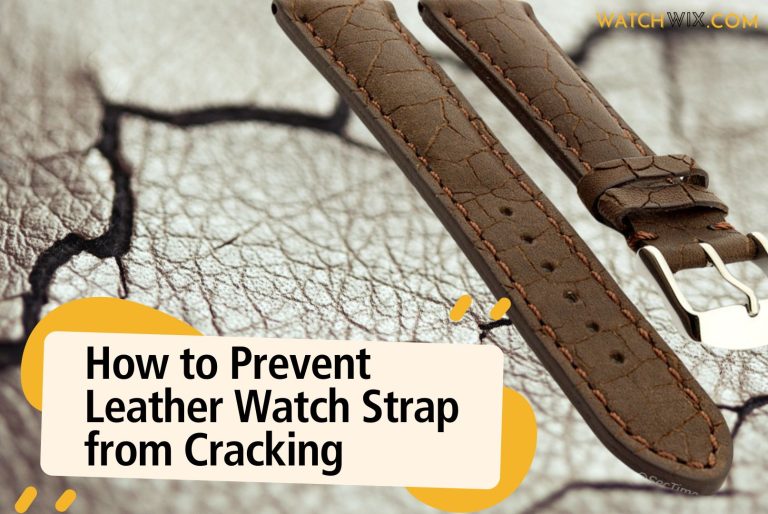



![Importance of Rolex Papers [2024 Detail Guide]](https://watchwix.com/wp-content/uploads/2024/05/Importance-of-Rolex-Papers-768x514.jpg)
